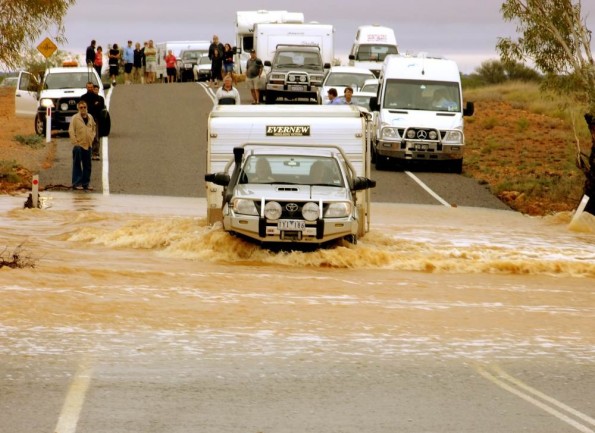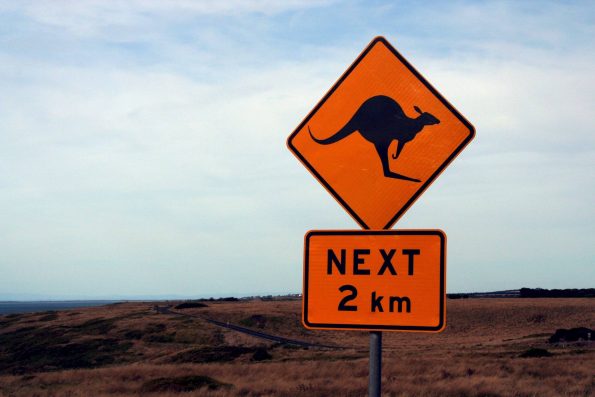With a huge variety of scenery and terrain to see in Australia, a road trip is absolutely essential, but you need to be prepared, especially if you’re heading into the outback. This checklist will see you right.
Prepping your vehicle
- Tyre pressures – check they are, at minimum, at the cold inflation pressure specified by the manufacturer. The cold level is when you measure your tyres when they are not warm (warm air expands). If you have to measure them warm, use this guide to see how much extra you need to put in. You can usually find this on a plate riveted to the door pillar, on a sticker inside the fuel flap, or in the vehicle’s manual. If you’re carrying a heavy load, e.g. 3+ people with luggage, then you’ll need to put more pressure in them (usually 3-4 psi). Make sure you check the spare, too.
- Tyre tread depth – the legal minimum is 1.5mm but wet weather performance drops off rapidly below 3mm which can make it really hazardous driving if you’re in an area that’s likely to get monsoon-style downpours. It’s best to look at replacing them once they get below 3mm.
- Emergency kit – if you’re only driving on sealed roads then you’ll just need a torch, reflective triangle and a jack. A hi-vis jacket and first aid kit are advisable, too. If you’re driving an older car which is less reliable, then you might want to take some tools if you know how to use them. If you’re heading into the bush where you’re unlikely to meet people if you break down then you will need more substantial emergency gear including:
- 20 litres of emergency water plus 4 litres per person per day
- personal locator beacon
- food
- spare fan belt, hoses and fuses
- tow rope
- shovel
- GPS and/or maps
- compass
- toilet paper
- lighter
- Check fluids – oil, windscreen washer, brake fluid
- Blankets – it can get cold at night – and an old towel for cleaning (helpful if you have to walk in mud, for example)
- Cargo barrier – important if you’re in a station wagon or hatchback and your gear is taller than the top of your rear seats
- Check lights
- Fill up with fuel
- Caravan or trailer – check the tyres and that everything looks roadworthy. Check everything is tied on and secure.

You can encounter all kinds of roads in Australia from scorching sand to flooded streams
Passenger comfort
- Snacks – healthy food is best, especially for the driver. Make sure you can access them easily. You might want to bring a cooler (particularly one that you can keep plugged into your car’s lighter socket, but bear in mind this will use more fuel)
- Pen and notepad
- Plastic bags for rubbish
- Tissues and wet wipes
- Smartphones and other devices plus a way of charging them (e.g. a charger that plugs into the lighter socket if your car doesn’t have USB connections)
- Toys and puzzles for kids in the car
- Books and magazines
- Music and podcasts (download them in case you are going to an area with no internet)
- Pillows
- Sunscreen
- Cash – good for purchases from roadside stalls, parking money, etc
- Printed instructions of your destinations and stopping points
- Binoculars and a camera
- Drinks – water is best, but anything than alcohol is better than nothing
- Multi-purpose knife (e.g. Swiss Army-style knife), cutlery and plastic plates
- Car sickness pills (important if you’re heading into windier roads in the hills)
Planning your stops and rests
- Have a written list of where you’ll stop – printouts of destinations with phone numbers are useful so you can call ahead if you’re running late
- An overnight bag if you are stopping for one night – it means you don’t have to unpack all your luggage. Be mindful of security, though, if you’re leaving your car overnight
- Share the driving and take breaks every 2-3 hours
- If you’re in the outback, avoid traveling when kangaroos and wallabies are at their most active (dawn and dusk)

Kangaroos are well camouflaged and can jump out in front of you
Leaving your home
- Take your regular luggage with you
- Leave your home looking like people are there to reduce the chance of burglary
- Ask a neighbour or friend to clear your mailbox
- Turn off appliances
- Set the alarm and lock everything up.
Being prepared
Breakdowns and getting lost where there’s no cellphone reception
- Stay with the vehicle and wait for assistance
- Make sure your vehicle is visible to other road users
- Put your bonnet up so that people know you’ve broken down
- Move other passengers into the shade to conserve water and energy
- Flag down a passing motorist to help
- If it’s nighttime, find your torch and hi-vis jacket as humans are very difficult to see at night
- If you don’t see anyone within a few hours activate your personal locator beacon
- If you don’t have a PLB and no one has arrived by nightfall then you’ll need to have everyone in the car to keep warm. Try to mark a help signal on the road in case a car comes along while you are sleeping, or take turns keeping watch. Stay with the car unless you know you are a very short distance from a house or settlement; there are too many dangers in the outback for you to be wandering aimlessly – dehydration, poisonous animals, injury and more. Plus, you don’t know if someone will come across your car while you’ve gone.
